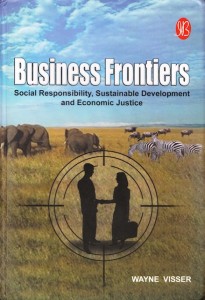The Life Story of a Global Movement
Blog by Wayne Visser
This new blog series for CSRwire is based on my book, The Quest for Sustainable Business. The book, in turn, follows a journey – around the world and through time; a journey of discovery and ideas. In the blog posts that follow, I will give you some glimpses into the search that has taken me to over 65 countries in the past 20 years. The path begins in Africa and winds its way through Asia, North America, Europe, Australasia and Latin America.
Along the way, I will share what I have learned in my encounters with mega-corporations and small farmers; and in conversations with CEOs and social entrepreneurs. I draw on facts and figures about world trends, and interviews with thought leaders and activists. This is a tale that consciously weaves the personal and the professional, mixing anecdotes and case studies. It looks outwards and reflects inwards, and is both autobiography and the life story of a global movement.
My inspiration for the book came when I decided, in 2010, to leave the security of the University of Cambridge – where I had been developing a Master’s in Sustainability Leadership – and set out on a ‘Corporate Social Responsibility (CSR) quest world tour’, which took me to 20 countries on five continents, travelling continuously for nine months. It was one of those great ironies of my life that I had to leave one of the world’s premier educational institutions in order to advance my learning.
Suffice to say I had an itch and I needed to scratch it. I wanted to reconnect with what was happening on the ground in countries around the world; and I was excited by the prospect of making new friends, seeing new lands, soaking up diverse cultures and discovering fresh case studies. More than anything, I needed to rekindle the passion that had started me on this career in sustainable business 20 years before.
My intention was always to capture my insights along the journey and share them with a wider sustainable business audience. One of the ways I did this was to conduct nearly 100 video interviews, all of which are shared on the CSR International channel on YouTube, and referred to throughout the text of the book.
The other way was to keep a diary and to write a book about my travel experiences—the book which forms the basis for this blog series. However, when I started to write, I repeatedly found myself referring to earlier parts of my career. Gradually, I began to wonder if there was a bigger story to be told. After all, my journey began in the lead-up to the Rio Earth Summit in 1992, and here we were, 20 years later, preparing for Rio+20.
In the interim, I had been fortunate to work, study, teach and research in the field of sustainable business, tracking its path as it emerged from a fringe concern to a mainstream movement and a global profession. There were stories to tell that ranged from hippie-like adventures in eco-villages and community enterprises to hard-nosed consulting assignments for big global brands. I had worked as a strategy analyst for Cap Gemini and set up and ran KPMG’s Sustainability Services in South Africa.
…
Continue reading
[button size=”small” color=”blue” style=”download” new_window=”false” link=”http://www.waynevisser.com/wp-content/uploads/2013/07/blog_csrwire1_wvisser.pdf”]Pdf[/button] The Life Story of a Global Movement (blog)
Related websites
[button size=”small” color=”blue” style=”tick” new_window=”false” link=”http://www.waynevisser.com/books/the-quest-for-sustainable-business”]Link[/button] The Quest for Sustainable Business (book)
[button size=”small” color=”blue” style=”tick” new_window=”false” link=”http://www.csrinternational.org”]Link[/button] CSR International (website)
Cite this blog
Visser, W. (2013) The Life Story of a Global Movement, Wayne Visser Blog Series, 19 June 2013.










